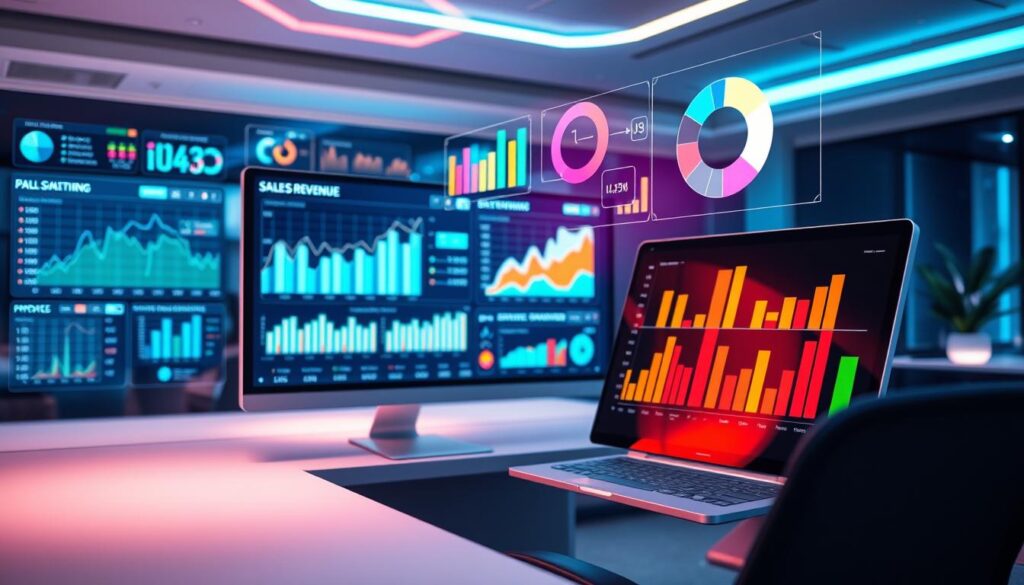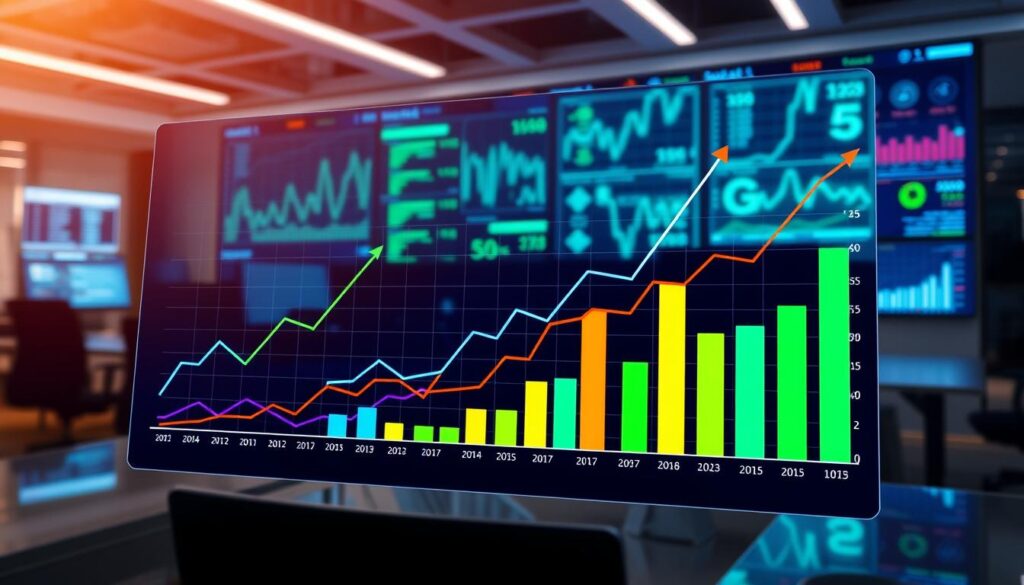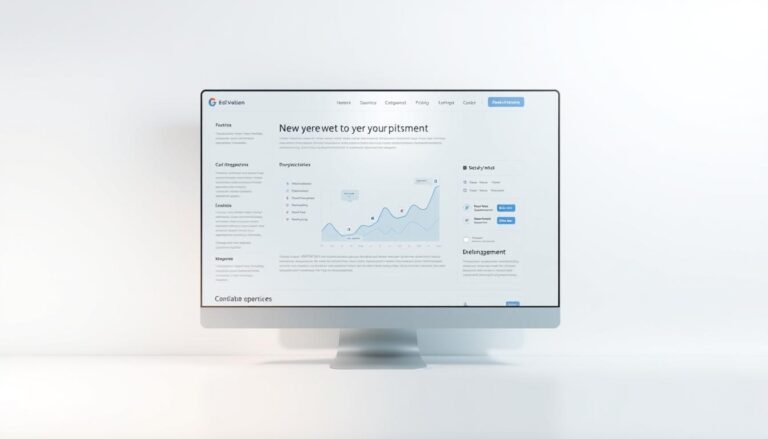In today’s ever-changing market, predictive sales revenue forecasting is key for companies wanting to thrive. It helps businesses navigate market complexities with ease. By using predictive revenue analysis, they get a clearer view of what lies ahead.
Thanks to AI and machine learning, old spreadsheet tactics are out. Sales teams now lean on data for better insights. This shift makes forecasting more precise and boosts sales and profits.
Finance, retail, and manufacturing sectors are all getting on board with sales trend forecasting. It makes planning more flexible and helps set realistic financial goals. The analytical might it brings lets companies foresee sales more accurately. It also helps align different departments, improving how they operate in the market to meet big goals.
Key Takeaways
- Embracing predictive sales forecasting can lead to a 10-15% increase in closed deals.
- Predictive sales revenue forecasting utilizes machine learning for greater accuracy.
- Real-time analytics and forecasting benefit strategic planning and resource allocation.
- Data quality and integration are essential for effective predictive sales forecasting.
- The fusion of AI and machine learning is projected to further refine forecasting models.
- Best practices in forecasting include regular updates, cross-department collaboration, and harnessing predictive analytics.
- Advancements in predictive analytics are essential for bolstering lead prioritization and customer retention.
What is Predictive Sales Revenue Forecasting?
Predictive sales revenue forecasting is a game-changer in sales strategies. It uses modern tech like AI and machine learning. The goal is to predict future sales. This method is more advanced than old-school forecasting, which only used past data and missed out on external market factors.
Definition and Importance
Predictive analytics for revenue is at the heart of this approach. It mixes different data types, such as real-time market situations and customer interactions. This helps businesses foresee how they’ll perform sales-wise in the future. These advanced methods give companies a way to deal with market changes confidently, adapting quickly to new issues and chances.
Key Components of Forecasting
- Real-time Data Analysis: Leveraging AI to analyze immediate data for timely predictions.
- AI-Driven Conversation Tracking: Monitoring customer interactions to forecast sales trends effectively.
- Automated Data Management: Utilizing AI tools to streamline data handling, significantly reducing manual effort and enhancing accuracy.
Differences from Traditional Methods
Predictive forecasting is different from traditional methods. Traditional ways mainly used past sales data. Predictive sales revenue forecasting, however, is about being proactive, not reactive. By using sales forecasting methods with predictive analytics, companies can change their strategies based on what’s happening now. This creates a solid plan for dealing with and even shaping the future of the market.
In the end, predictive sales revenue forecasting gives businesses an edge. They can make early changes to their sales plans, using data and analysis. The aim is to do better and make more money as the market changes.
The Benefits of Predictive Sales Revenue Forecasting
Using predictive forecasting techniques with advanced analytics changes how businesses predict future revenues. It makes forecasts more precise, improves how resources are used, and sharpens strategy planning. These forecasting tools for sales are key for businesses wanting to stay competitive. Let’s see how predictive insights can lead to smarter business choices.
Increased Accuracy in Forecasts
One major perk of using predictive analytics in sales trend forecasting is more accurate forecasts. By using AI and machine learning, companies can quickly and accurately analyze data. This includes past sales, market trends, and what customers are doing. For example, teams that use AI for forecasting see up to a 41% boost in accuracy. This proves its strength in keeping up with fast-changing markets.
Better Resource Allocation
Predictive forecasting techniques make it easier to use resources well. This includes inventory, staff, and money. By accurately predicting sales, companies can use their resources better. This way, they’re ready for what’s coming without wasting money or resources. Predictive analytics can also help plan maintenance to reduce downtime in production.
Enhanced Strategic Planning

Predictive analytics are crucial for planning strategies. They give companies insights into future market trends and what customers might want. This broad view helps companies make proactive plans that match future market and customer needs. This leads to better competition and more innovation. Predictive insights allow companies to shape their market environment by anticipating changes, not just reacting to them.
In summary, using predictive sales revenue forecasting helps businesses in many ways. It makes forecasts more accurate, improves resource use, and leads to smarter strategic decisions. As markets get more complex, using advanced forecasting tools is essential for success.
Tools and Technologies for Effective Forecasting
In sales, using new tools and tech is key. They make revenue projection models better and more accurate. Special software and systems are crucial for predictive modeling in sales. They impact predictive analytics for revenue directly. Let’s explore the main tools companies use to make revenue forecasting better.
Data Analytics Software
Data analytics platforms use past data to make better forecasts. Tools like Weflow and Gong.io turn big data into insights. This helps businesses grow accurately. Weflow supports team forecasting and updates based on real-time changes, starting at $39/user/month. Gong.io works with over 100 data sources. It boosts forecast accuracy with AI-powered analytics.
Machine Learning Algorithms
Advanced machine learning algorithms change how we see revenue projection models. They find trends that humans might miss. For example, Mediafly Intelligence360 uses these trends to check human guesses, starting at $65/seat/month. It ensures forecasts are reliable. Forecastio.ai, for $149/month, is perfect for HubSpot CRM users. It shows how specific targeting and machine learning make forecasts more accurate.
Customer Relationship Management (CRM) Systems
CRM systems collect vital sales and customer data. This data is the backbone of any sales prediction strategy. Anaplan and Clari mix CRM with predictive analytics. Anaplan costs between $30,000 and $50,000 a year. Clari costs between $12 and $50 per seat/month. They show how investing in CRM meets different business needs and forecasting goals.
In conclusion, modern tools like data analytics software, machine learning, and CRM systems are essential. They help companies improve their predictive analytics for revenue. Each tool brings unique benefits. Together, they make sales forecasting comprehensive and precise. This ensures companies stay ahead in the market.
Key Metrics in Sales Revenue Forecasting
Starting with predictive sales forecasting means looking closely at important metrics. These metrics tell us about a business’s health and future growth. Predictive revenue analysis uses these metrics to make sales better and forecasts more accurate.
Sales Growth Rate
The sales growth rate shows if a company’s sales are increasing over time. It’s a key measure for understanding performance and future trends. Keeping an eye on this helps businesses update their sales approaches based on what the market needs.
Customer Acquisition Cost
Knowing how much it costs to get a new customer is key. It shows if marketing and sales efforts are working well. This figure also tells us if these strategies will be profitable over time.

Customer Lifetime Value
The value of long-term customer relationships is huge for a company. Understanding this value helps in focusing resources to increase profits from these relationships.
Using forecasting tools for sales improves the accuracy of forecasts. These tools turn data into useful insights. This helps businesses adjust their strategies for better results.
Adding these important metrics to predictive revenue analysis helps spot current sales trends. It also makes future sales predictions more precise. With predictive sales forecasting, companies can be ready for market changes. This leads to ongoing growth and higher profits.
Best Practices for Implementing Forecasting Techniques
In the complex world of sales forecasting, businesses aim to use the best predictive methods. They work to ensure they can predict sales and revenue accurately. Staying ahead in the market is key to their success.
Data Collection and Integration
For a forecast to work well, gathering high-quality data is essential. Businesses should collect detailed sales data and include other factors. These include market trends and the economy, which affect forecasts greatly. Improve your sales forecasts by making sure data is complete and consistent everywhere.
Regular Updates and Reviews
Businesses change fast, so forecasts need regular updates. Revisiting your revenue projection models helps keep pace with these changes. It’s good to update forecasts at least once a month to stay current.
Cross-Department Collaboration
Forecasting needs input from all parts of a business, not just sales. By working with departments like finance and marketing, forecasts become more reliable. This teamwork helps create a forecast that reflects the whole business.
| Type of Forecasting | Relevant Techniques | Contributing Departments |
|---|---|---|
| Opportunity Stage | CRM Data, Sales Cycle Analysis | Sales, Marketing |
| Time Series | Historical Trend Analysis, Seasonality Checks | Finance, Supply Chain |
| Lead Driven | Lead Quality Data, Conversion Rates | Sales, Marketing |
| Retail Sales | Market Analysis, Promotional Impact | Marketing, Sales |
By following these best practices, firms can make their sales forecasts true strategic tools. Mixing predictive forecasting techniques, insights from various departments, and tech tools leads to effective forecasts. This supports business goals well.
Common Challenges and Solutions
Predictive sales forecasting can really help companies with their revenue plans. But, it can be tough to get right in tricky markets. We’ve listed some common problems and their solutions. These tips can help businesses make the most of sales forecasting.
Data Quality Issues
Maintaining accurate data is key in predictive sales forecasting. Outdated or lacking data can mess up forecasts. Companies should ensure their data is clean and up-to-date. This means checking data regularly and keeping your info current with market and company changes. Using good CRM systems helps by keeping all data centralized and fresh.
Overreliance on Historical Data
It’s important not to depend too much on past data. Ignoring current events can lead to inaccurate forecasts. By using up-to-date data and adjusting models for new info, forecasts become more accurate. This helps businesses react better to market changes and opportunities.
Adapting to Market Changes
Being adaptable is really important in fast-changing markets. Predictive analytics helps businesses stay ahead by forecasting market shifts. Using tools that value newer data can keep forecasts relevant. A mix of quantitative and qualitative methods also helps. This approach considers various factors, like economy and customer trends.
Let’s look at how different forecasting methods size up against these challenges:
| Forecasting Method | Benefits | Considerations |
|---|---|---|
| Moving Average | Smoothens out short-term fluctuations and highlights longer-term trends. | May lag behind when market conditions change rapidly. |
| Exponential Smoothing | Gives more weight to recent data, enhancing responsiveness to market changes. | Requires choosing the correct smoothing constant for best performance. |
| Regression Analysis | Identifies key variables affecting sales to predict future revenue accurately. | Demands high data quality and skilled statistical analysis. |
| Qualitative Analysis | Integrates expert opinions which can be beneficial in new or shifting markets lacking sufficient data. | Subjective and potentially biased if not properly managed. |
By knowing each method’s pros and cons, businesses can better navigate predictive sales forecasting. This boosts their chances of predicting and benefiting from future revenue opportunities.
Future Trends in Predictive Sales Revenue Forecasting
Businesses are witnessing rapid changes due to tech advances and more data use. Predictive sales revenue forecasting is getting smarter, improving how we predict future sales. With the rise of artificial intelligence (AI) and machine learning, sales teams can stay ahead in a changing market.
Artificial Intelligence and Machine Learning
AI and machine learning lead the way in better forecasting. These tools help companies quickly analyze big data, spotting trends that might be missed otherwise. Sales forecasts become quicker and more accurate, thanks to these technologies. They consider various factors, making companies more adaptable to economic changes and industry challenges, especially looking towards 2024.
The Role of Big Data
Big data plays a huge role in sales forecasting today. Companies have access to vast amounts of data, from transactions to customer interactions and beyond. Through advanced forecasting tools, this data provides deep insights into sales trends. Big data helps businesses forecast more dynamically, keeping up with quick shifts in consumer behavior and market trends.
Integrating Predictive Analytics into Business Strategy
Predictive analytics is becoming a key part of business operations. Organizations are weaving these analytics into their strategic planning. Tools like 6sense and BoostUp show how predictive analytics can improve sales strategies. This approach enhances planning efforts across the board. It also boosts marketing, inventory management, and overall efficiency.
FAQ
What is Predictive Sales Revenue Forecasting and why is it important?
Predictive Sales Revenue Forecasting uses advanced analytics and AI to foretell future sales. It helps companies make smart decisions and plan better. By using real-time data, they can aim to close more deals.
What are the key components of predictive sales forecasting?
Key parts include integrating current data and tracking conversations with AI. There’s also automated management and predictive models. Together, they create an accurate forecast.
How does predictive sales forecasting differ from traditional methods?
This forecasting uses AI to look at a wide range of data, including external factors. This approach is usually more precise than old methods. Traditional ways often only look backward.
What are the benefits of predictive sales revenue forecasting?
Benefits are more exact forecasts and smarter use of resources. This leads to better planning and aligning sales with company goals. Consequently, businesses become more efficient and adaptable.
What tools and technologies are used for effective predictive sales revenue forecasting?
What are the key metrics in sales revenue forecasting?
Important metrics are sales growth rate, cost to acquire customers, and their lifetime value. These help understand sales performance and guide planning.
What are the best practices for implementing predictive sales forecasting techniques?
Good practices include careful data collection and updating the forecast model regularly. Also, working together across departments is crucial. These steps ensure forecasts are on point and comprehensive.
What are some common challenges in predictive sales forecasting, and how can they be addressed?
Challenges include issues with data quality and relying too much on past data. To tackle these, maintain strong data management, use algorithms that consider current data, and adapt fast with tools like 6sense.
How will future trends like AI and big data shape predictive sales revenue forecasting?
AI and big data will make forecasts even more accurate by using more diverse data. As these technologies are woven into business strategies, they’ll guide decisions at every sales level.



